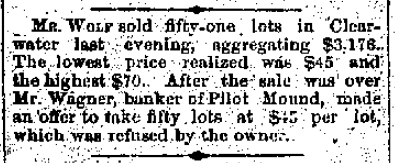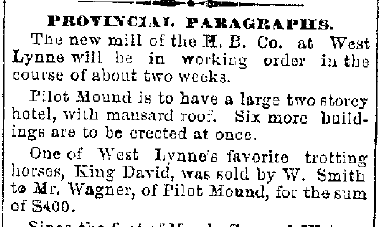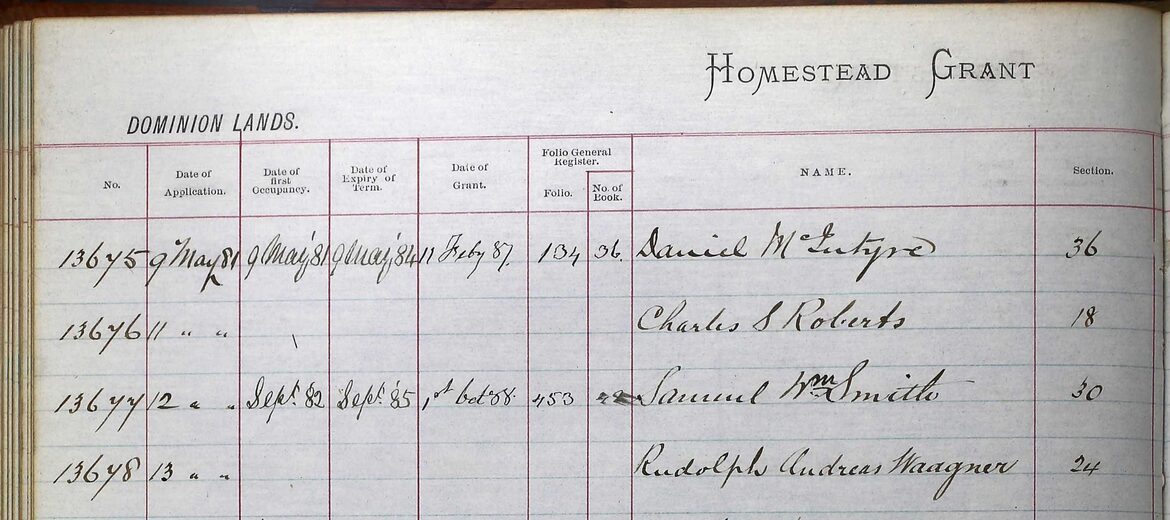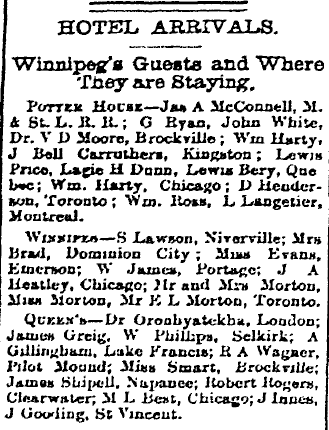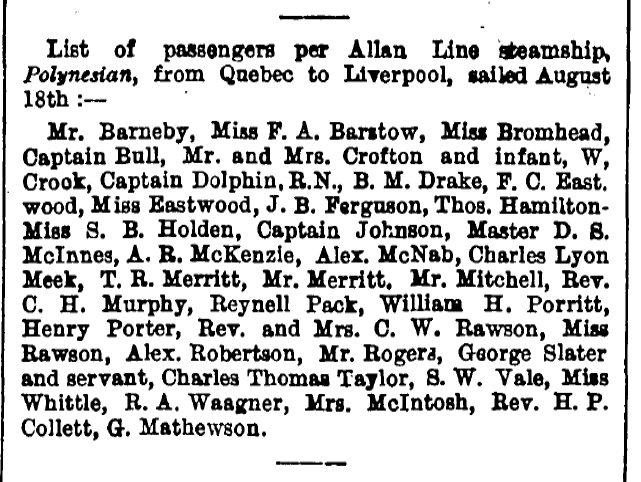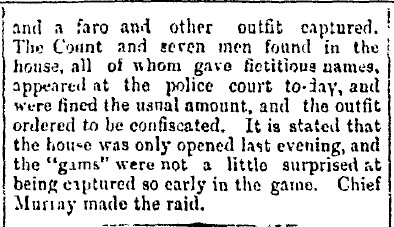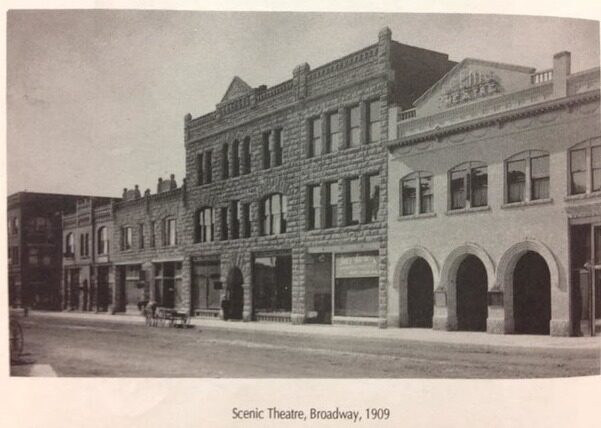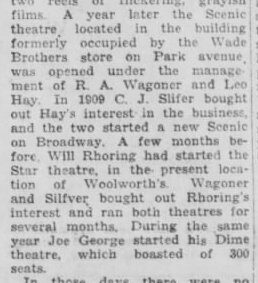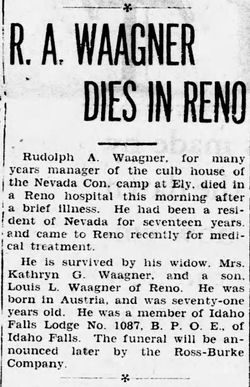I have a deep fondness for local history, which explains why I can often be found, nose to a computer or in an ancient book, reading and researching the pioneers who settled in this area. A question popped into my mind after re-reading a firsthand account by early Pilot Mound settler J. M. Fraser of a new resident to Pilot Mound.[1]
“One of our new settlers was Rudolf Von Wagner, a count from Austria. He had the best of clothes, received large quarterly remittances, was the politest of men when he wished, had a terrible temper when crossed, shot a pony because it balked, shot a nice dog because it would not retrieve properly. He did not like something Mr. William Robertson said to him one day, and he said, “If it were not for your age I would thrash you.” Mr. Robertson squared up to him and said, “Never mind my age. Come on!” But he flunked. He homesteaded part of 24, 3-12 and after a few years drifted to Winnipeg and disappeared. Wagner wanted to buy an interest in my store but I did not want him.”
An Austrian Count? In Pilot Mound? Pioneering the wild prairie wool? I was instantly intrigued to discover what kind of man Rudolf Von Wagner had been, especially after reading such a vivid and scathing description of him. I thought that the best strategy was to attempt to answer the questions that Fraser’s memories posed and see where it led me. So the chase, albeit from behind a computer screen, was on!
Placing him here in the Pilot Mound area was the first step. As the Canadian west was opening up to the world there were many people who floated through from all corners of the earth. Not all wanted to farm; many could see a prosperous future in supplying goods and services to those who were homesteading. The 1881 Canadian census[2] documented Waagner as living on his claim on the N ½ of 24-3-12. He stated in the census that he was 25 years old, a banker and was born in Austria. His name was spelled Waagner and remains that way on every subsequent document pertaining to him.

To validate his ownership of the land, I searched through the Land Grants of Western Canada[3]. He filed a claim on 13 May, 1881 on the North ½ of 24-3-12.
He seems to have made his mark on the population while he was here. Waagner may have indeed had the large trust fund or quarterly payments to him that was mentioned by Fraser. There are not many 25 year olds that could set themselves up as a banker let alone make offers to purchase on large lots of land.
Land speculation may have been his intention while he was here, not the common mans pursuit of farming.
This bit of news in the Winnipeg Free Press from August 16, 1882 stands out. Since coming into the new town of Pilot Mound he has received two refusals of offers to purchase from different businessmen. It can’t be verified whether or not he had the means to cover these but it is certain that neither Mr. Fraser nor Mr. Wolf wanted much to do with Waagner’s business propositions. The clipping tells even more about the funds he may have had at his disposal. Purchasing a horse from West Lynne, a tiny community that was diminished by the completion of the railway at Emerson, Manitoba in the early 1880’s, would have meant a great, and expensive, distance to travel for this horse. If Waagner was to buy this same horse at today’s currency rates, he would have bought nearly $10,000 in horse flesh. It certainly seems that nothing but the best would do for him.
Further proof of Mr. Fraser’s account of him leaving, Waagner cancels his land claim. We can only imagine the impression he left on the citizens of the area if Fraser is still recalling the man some 50 years on.
Waagner does leave Pilot Mound in the fall of 1882 for what might be the more lucrative lights of Winnipeg. As was the custom of the time, hotels published the names of their guests; he was registered at the Queen’s Hotel, located at the Portage Avenue and Notre Dame.
I was unable to find any documentation that would tell of his time spent in Winnipeg between October of 1882 and the 18th of August, 1883 when I spotted him again. Waagner is aboard the Liverpool bound Allen Line steamship, The Polynesian. I wondered if this was the end of the line of his Canadian adventure. There are more than a few stories about young men from Britain and Europe who went home, defeated and spent, from their dream of becoming a farmer in Canada.
Not Rudolf Waagner. We can only theorize what made him head to Britain - believe me, I have. My first assumption was he was on his way home to Austria. I had speculations of a death in the family, marriage, legal matters and maybe another dip into the trust fund. For now, it will have to remain a mystery. There are so very few surviving records for Austria, as two World Wars made a significant impact to their archives and government buildings. Waagner doesn’t stay away long from Manitoba and his return does not begin smoothly. On May 1, 1885, there’s a raid on a gambling house in Winnipeg, said to be under the management of a “Count”.
Named Wagner.
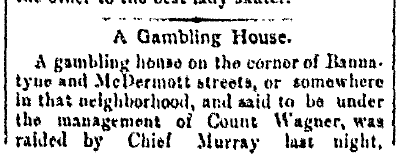
My eyebrows lifted a bit on this one. I weighed out the possibilities of there being two men named Waagner/Wagner that might be royalty or at least claiming the title of “Count” in Winnipeg at the same time. I scurried through the rest of 1885 to find his court date: September 10.
“Count” Wagner was fined $20, about $500 today. By now, he is known to police and they are probably keeping an eye on the “Count” and those who were fined along with him. Further records of Waagner anywhere in Manitoba were not to be found, so I cast my net a bit wider.
His next base begins to give a glimmer of the type of man Mr. Waagner was and also the time in which he lived in. The West in both Canada and the United States was set for those who wanted adventure. A record found from Montana launches his American journey; on the 10th of August, 1892 he signs a Declaration of Intention to become a citizen of the United States[11]. He signs this in Bozeman, Gallatin County, Montana.
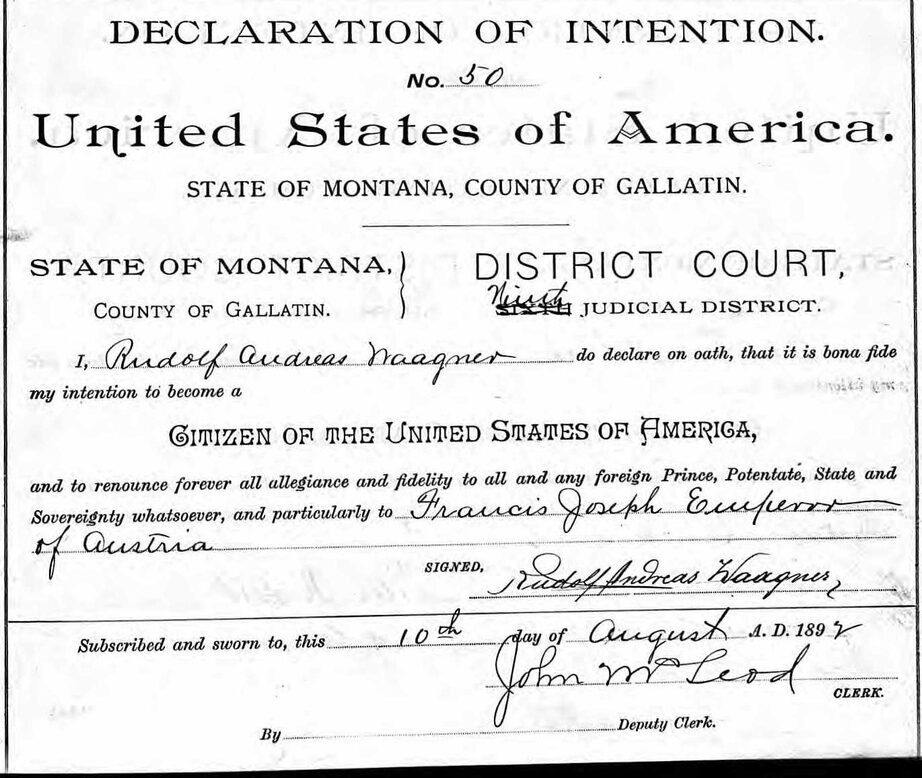
A quick search of the area surrounding Bozeman and it becomes clear what Waagner is doing in Gallatin County, which borders the famous Yellowstone National Park. Dedicated on 1 March in 1872 by President Ulysses S. Grant, Yellowstone became the first U.S. National Park.[12] The first mention of Waagner is in letters he has written to the US Park service while working as a Scout in the park. In short time he becomes a Game Warden, a career he took quite seriously. There are innumerable letters, documents and newspaper articles about him. He became a local legend at the time, gaining yet another somewhat aristocratic nickname of the “Duke of Hell Roaring Creek”; the threateningly named creek being within the boundaries of his jurisdiction.

This listing is from a yearbook of National Park employees in 1903. Waagner was employed as a Scout for a few years before he became a Game Warden in the park.

He was a prolific letter writer while he was at Yellowstone. The Yellowstone National Park Archives holds nearly 70 letters he wrote for various reasons. They also have many of the communications he received while there.
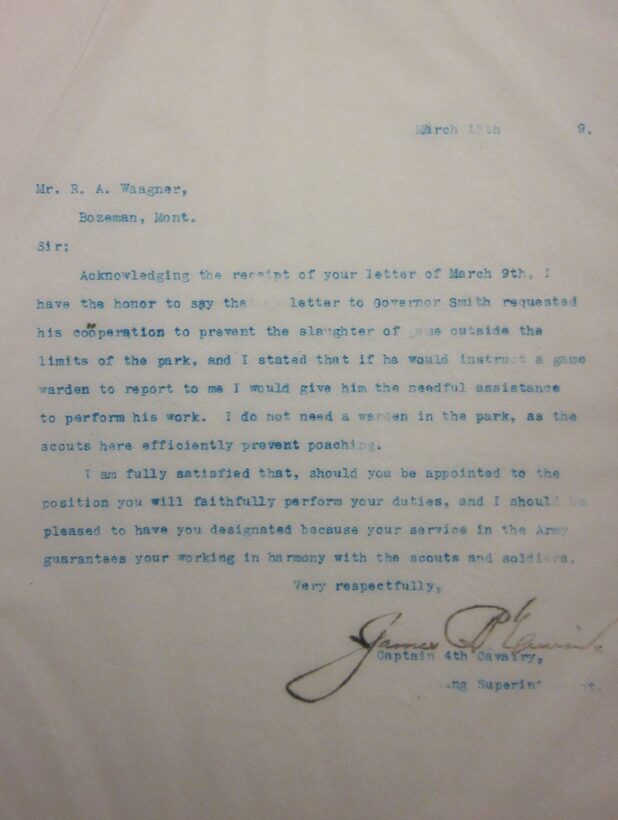
The only mention of a wife for Waagner comes from the 1900 US Census. He and his wife Louisa were living in the Spanish Creek Precinct, Gallatin County, Montana. Waagner was 44 and his wife is 30. They have no children and have been married for 11 years. That would make the year of their marriage around 1888. Louisa is also Austrian, stating it as her birthplace. In the column for year of immigration to the US is recorded as 1891.
In April of 1903, a famed naturalist, John Burroughs, joined then President of the United States, Theodore Roosevelt, on a two-week camping trip to Yellowstone. Burroughs recounted their time together in a book called “Camping and Tramping with Roosevelt.” Their little party happened to meet Waagner and he certainly made as much of an impression to them as he had in Pilot Mound some 20 years earlier.
“Our destination this day was a camp on Cottonwood Creek, near “Hell-Roaring Creek.” As we made our way in the afternoon along a broad, open, grassy valley, I saw a horseman come galloping over the hill to our right, starting up a band of elk as he came; riding across the plain, he wheeled his horse, and , with the military salute joined our party. He proved to be a government scout, called the “Duke of Hell Roaring,” – an educated officer from the Austrian army, who, for some unknown reason, had exiled himself here in this out-of-the-way part of the world. He was a man in his prime, of fine, military look and bearing. After conversing a few moments with the President and Major Pitcher, he rode rapidly away.”[18]
The first photos that I uncovered of Waagner are from this time. He was photographed several times by Layton A. Huffman, a pioneer of photography who captured the people and activities of the early Western United States.
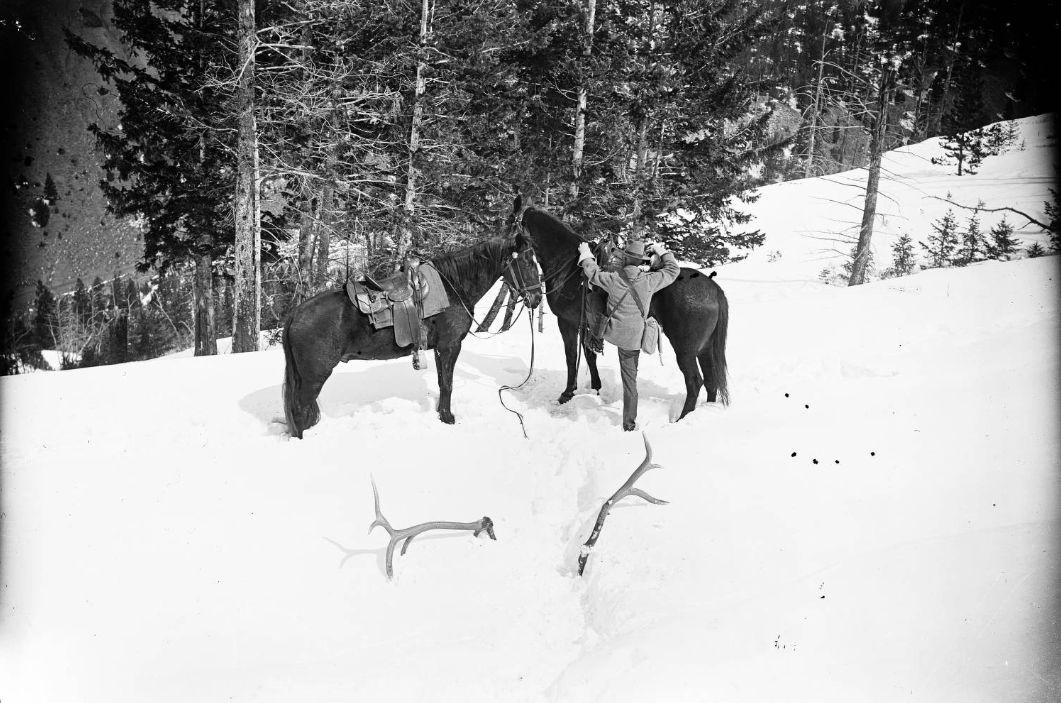
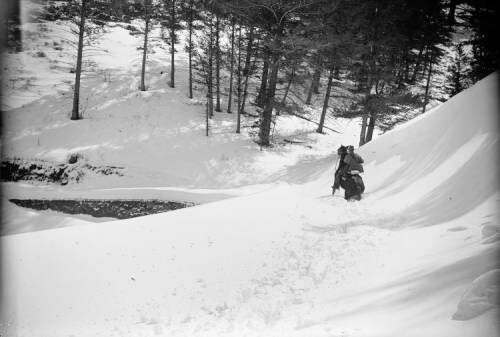
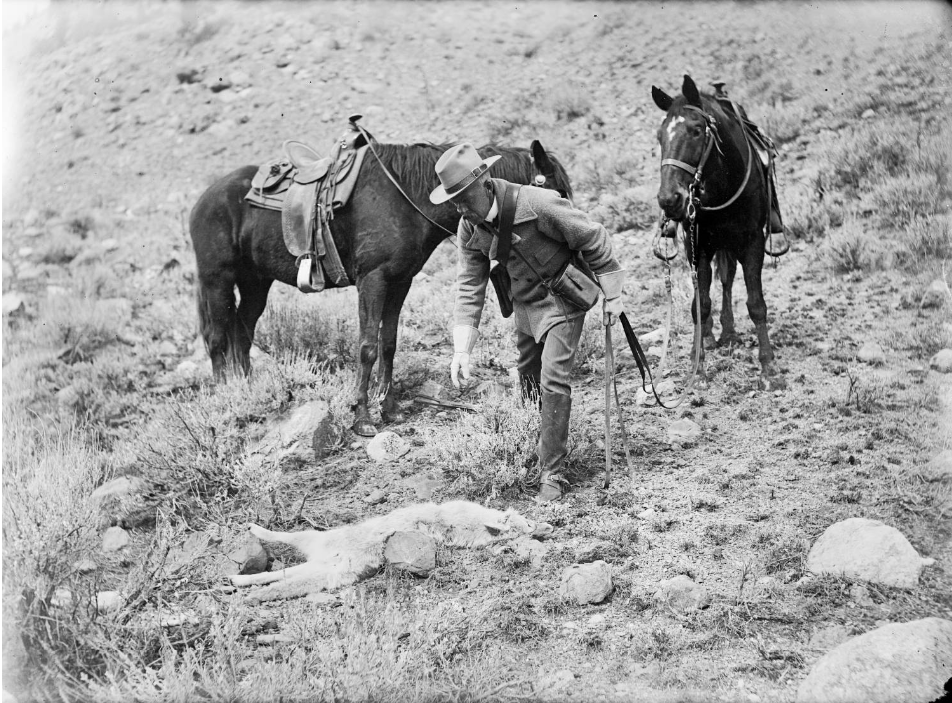
[21]Huffman titled this photo “Days with the Duke of Hell Roaring, finding the dead coyote.”
Likely influenced by his European upbringing, he appears to take great care in his attire; one can see by his coat, boots and gloves that he is well dressed. Waagner was also mentioned in the book “Death in Yellowstone: Accidents and Foolhardiness in the First National Park By Lee H. Whittlesey. A snippet in the book tells of Waagner’s efforts in aiding to find a soldier who had been buried by an avalanche. The story gives additional insight into the life of a scout in the Park.
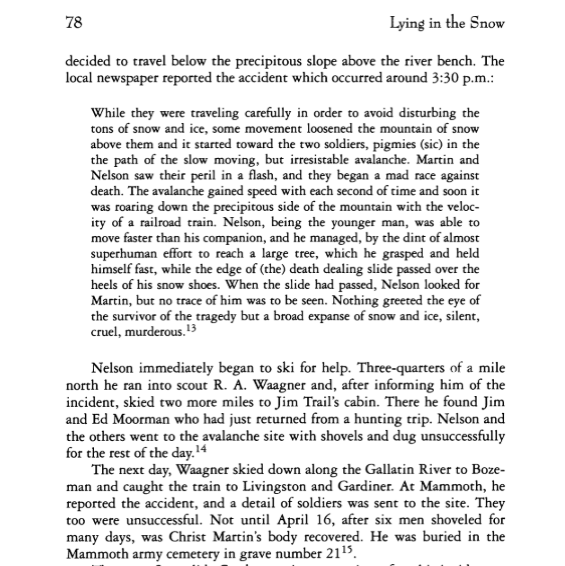
Expecting to find Waagner on the 1910 US Census in Montana, I was intrigued to find him in Idaho Falls, Idaho.[23] The census was taken on 7 May, 1910 and Waagner reports some updated information about himself. Now 54 years old, he’s widowed and for his occupation he states that he’s a Showman at the Scenic Theatre. The 1911 Idaho Falls Directory lists Waagner as a Manager at the Scenic Theatre along Claude J. Slifer. [24] The Scenic Theatre served as a venue for travelling Vaudeville acts and touring theatre troupes.

Why is this “Duke” choosing to reinvent himself again? There is no doubt the life of riding horseback daily and patrolling the park at Yellowstone would start to take its toll on his aging body. Titling himself as a Showman, one could imagine that Waagner was either a daily “Emcee” of the shows or perhaps he would tell tales of his life in the saddle in Yellowstone.
To assume that he had settled down in his new life in Idaho Falls was folly. No more records of Waagner in Idaho are to be found after this time. After the next step of looking for him on the 1920 US Census, he appears as remarried and living in Ely, White Pine County, Nevada. A little over 400 miles from Idaho Falls, Ely at that time was a mining town surviving on the nearby copper mines. Waagner was now 65 and married to new wife, Katherine, who is 31. They also have a son, 14 month old Louis. It’s curious to note that Louis’s birthplace is reported as being Illinois which makes one wonder if he is Waagner’s own child or did Katherine give birth to him prior to their marriage. Although they were reported as married on the 1920 census, their marriage certificate is in fact dated five years later, on 12 Aug, 1925 in Ely, Nevada.[27] It can be assumed that he and Katherine were living together unmarried for a time, although the arrangement would have been frowned upon by polite society. Since there is little in this story that demonstrates that Waagner adhered to convention, raised eyebrows likely bothered him very little.
In 1927, the family can be found living at 139 Washington St in Reno, Nevada.

As with all good stories, there is an ending. With Rudolf Andreas Waagner, his end comes with his death in Reno, Nevada on 30th Jan, 1928.
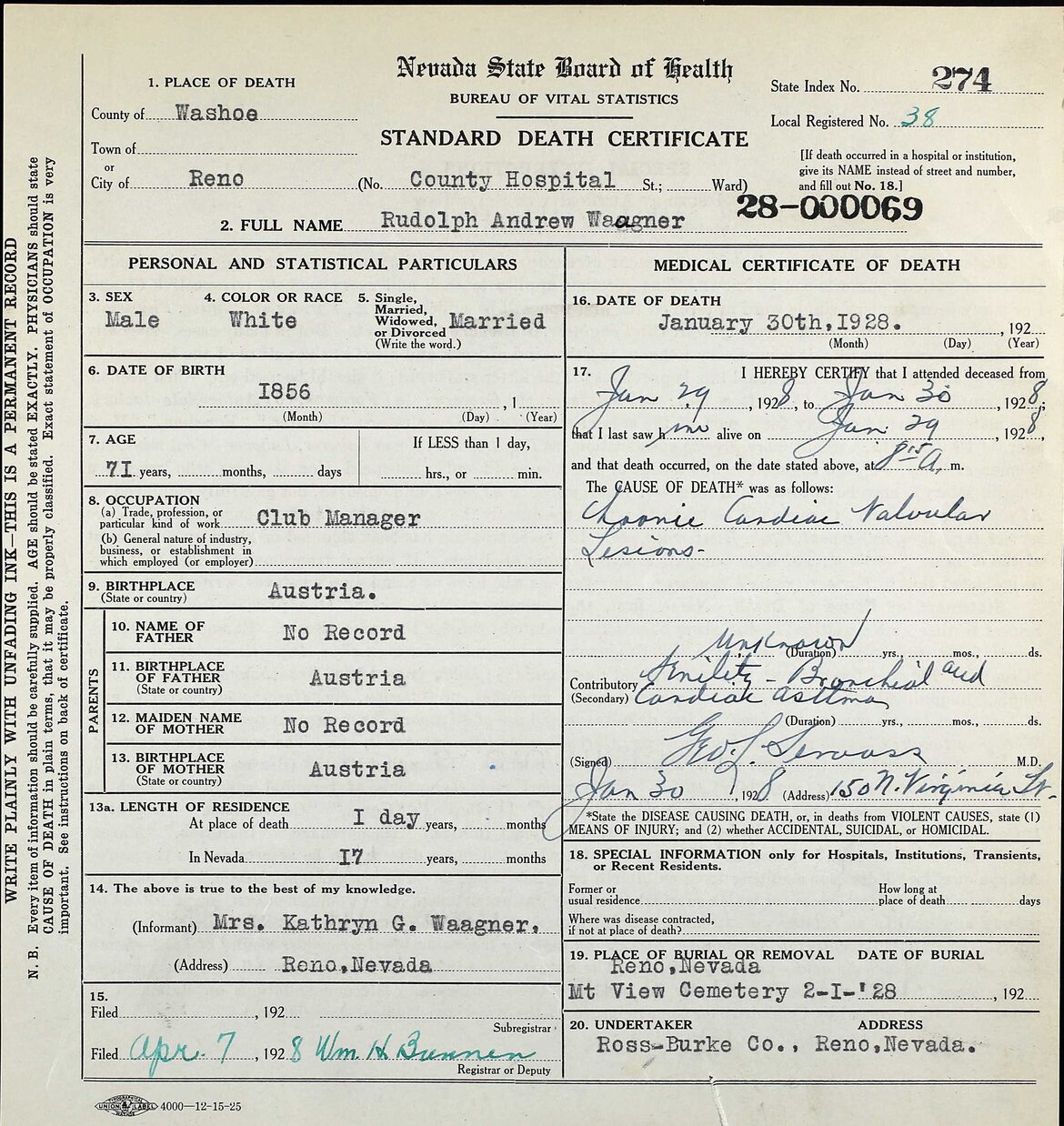
I couldn’t stop with Waagner’s death. I did trace Katherine and Louis’s movements in the years after. She quickly remarried, and Louis served in the U.S. Army for nearly the entirety of WWII. He died in Florida in 1995. I have traced Louis’s children and maybe someday I will reach out and ask them if they know the story about their ancestor. Perhaps they don’t know of his travels, adventures and the many hats he wore.
What started as a personal need to prove that this man was likely no more a Count than I was, very quickly morphed into a fast paced jaunt through time. Waagner was here in Pilot Mound at a time where no lights were yet seen on the prairies at night. He was here at time in North American history where a man could pull up stakes and try again - and he did that many times. He sparked my curiosity from the beginning and with each document uncovered I was pulled in that much deeper. I have answered some of my original questions but there is little doubt that each time I discover a new database or repository that might pertain to him, his name will be one of the first I try in an effort to unearth him further.
My husband, who had to suffer through all of my excited shouts of another new discovery, has a theory on Waagner’s choices of new locales: A young man, who grew up among the Austrian mountains, comes to Canada. On a map he sees a place called Pilot Mound. There are plenty of tales of men, recent arrivals to the New World, just picking anywhere to claim their land, sight unseen. The mound wasn’t big enough to keep him closed in, but every subsequent place he lived was surrounded with amazing mountains views. Maybe Waagner was just looking for a place that felt like home, and a place that would yield to his desire to create his own mark on the world.

Original data: Homestead Grant Registers. R190-75-1-E. Library and Archives Canada, Ottawa, Ontario, Canada. ↑
Original data: Homestead Grant Registers. R190-75-1-E. Library and Archives Canada, Ottawa, Ontario, Canada. ↑
Original data: Thirteenth Census of the United States, 1910 (NARA microfilm publication T624, 1,178 rolls). Records of the Bureau of the Census, Record Group 29. National Archives, Washington, D.C; Census Place: Idaho Falls Ward 1, Bingham, Idaho; Roll: T624_222; Page: 2B; Enumeration District: 0055; FHL microfilm: 1374235. ↑
Original data: Death Records. Nevada Department of Health, Carson City, Nevada; State File Number Range: 28-000001 - 28-000394 ↑
